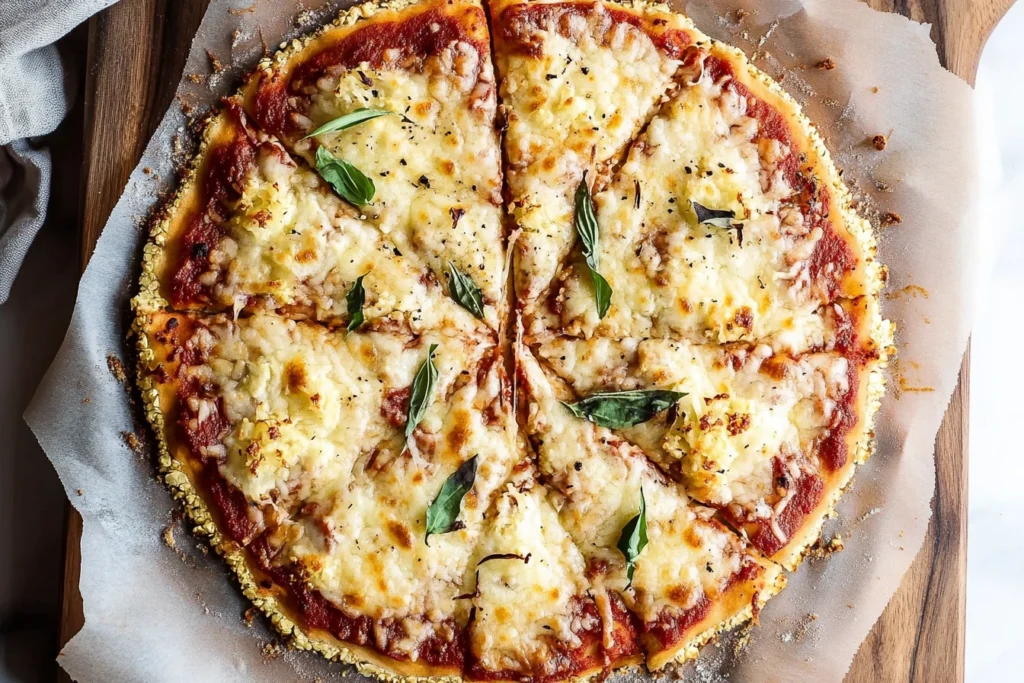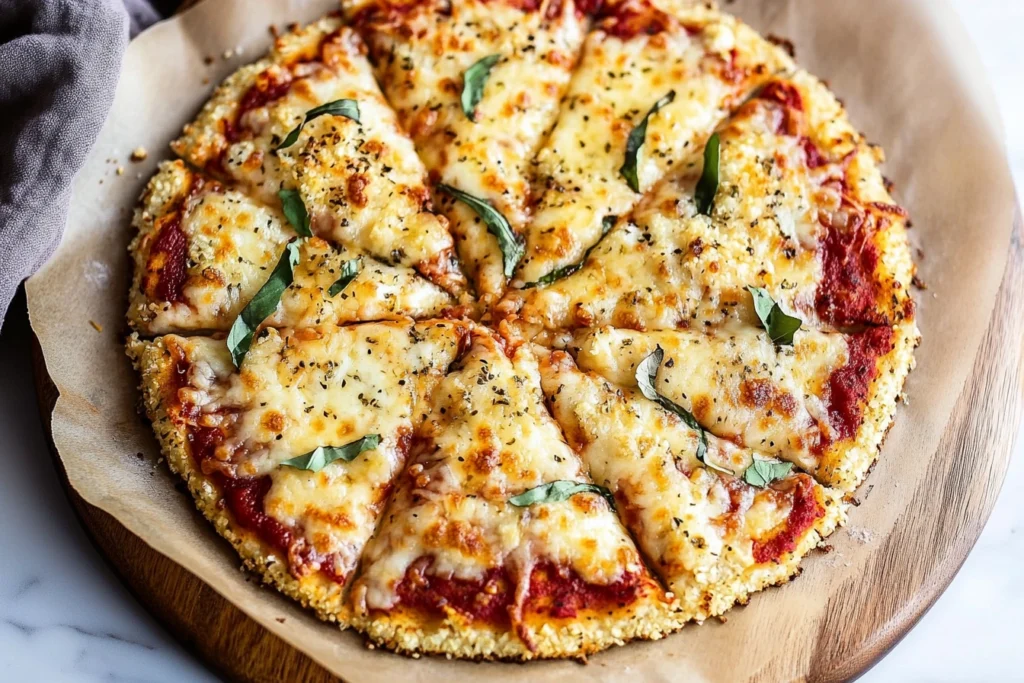Cauliflower pizza crust has become the go-to option for those looking to enjoy pizza without the guilt. Whether you’re following a gluten-free, keto, or low-carb lifestyle, this crust offers a nutritious and versatile foundation for countless toppings. In this article, we’ll dive into everything you need to know, from making it at home to discovering the best store-bought options, and even creative topping ideas. Let’s get started!
Introduction to Cauliflower Pizza Crust
What is Cauliflower Pizza Crust?
At its core, cauliflower pizza crust is exactly what it sounds like a pizza crust made from cauliflower. But don’t be fooled by its simplicity. This ingenious alternative swaps out traditional flour-based crusts for a mixture of finely grated cauliflower, cheese, and eggs. The result? A lighter, healthier option that still satisfies those pizza cravings.
Why is it Popular?
Well, who doesn’t love the idea of guilt-free indulgence? Cauliflower crust has skyrocketed in popularity due to its low-carb and gluten-free benefits. It’s not just for those with dietary restrictions either; even pizza enthusiasts are jumping on board, praising its flavor and texture when done right.
The Growing Demand for Gluten-Free Alternatives
The rise in gluten-free living isn’t just a trend, it’s a lifestyle change for many. Whether driven by medical needs like celiac disease or personal choices, the demand for gluten-free options has turned everyday classics like pizza into innovative creations like cauliflower crust. It’s one of the many ways people are proving that health and flavor can coexist.

Health Benefits of Cauliflower Pizza Crust
Low in Carbs and Calories
One of the standout advantages of cauliflower pizza crust is its low-carb, low-calorie profile. Unlike traditional crusts made from wheat or white flour, this alternative keeps carb counts minimal, making it a favorite for those on keto or low-carb diets. With fewer calories per slice, you can enjoy your pizza without feeling weighed down or worrying about derailing your health goals.
High in Fiber and Nutrients
Cauliflower isn’t just a trendy ingredient; it’s a powerhouse of nutrition. Packed with fiber, it aids digestion and keeps you feeling full longer. Plus, cauliflower is rich in vitamins like C and K, as well as antioxidants that help fight inflammation. Eating pizza with a cauliflower crust doesn’t just satisfy cravings, it supports your body’s overall wellness.
A Great Option for Special Diets
Whether you’re following a gluten-free regimen, experimenting with a low-carb lifestyle, or sticking to a keto plan, cauliflower pizza crust fits seamlessly into most special diets. It provides the flexibility to enjoy a classic dish without straying from your goals. And it’s not just for diet-focused individuals; families are also embracing this crust as a way to sneak more vegetables into meals for kids and adults alike.
Supports Weight Management Goals
Because it’s lower in calories and carbs, using cauliflower crust can help maintain or even reduce weight when paired with healthy toppings. It satisfies cravings while keeping portions under control a win-win for those trying to stay fit without giving up their favorite foods.
How to Make Cauliflower Pizza Crust at Home
Ingredients You’ll Need
Making a delicious cauliflower pizza crust at home doesn’t require a fancy shopping list. Here’s what you’ll need:
- Cauliflower: Fresh or frozen, riced or whole (you’ll be breaking it down).
- Eggs: Acts as a binder for the crust.
- Cheese: Mozzarella and Parmesan are popular choices for flavor and texture.
- Seasonings: Garlic powder, oregano, salt, and pepper to enhance the taste.
Optional additions like almond flour or flaxseed meal can add structure, but they’re not essential.
Step-by-Step Recipe
- Prep the Cauliflower:
Wash the cauliflower and chop it into florets. Use a food processor to pulse it into rice-sized bits. If using frozen cauliflower rice, thaw it completely and squeeze out excess water with a clean towel. This step is crucial to avoid a soggy crust! - Cook the Cauliflower Rice:
Microwave the riced cauliflower for 4–5 minutes or steam it on the stove. Allow it to cool, then press out as much moisture as possible. - Mix the Ingredients:
In a bowl, combine the dry cauliflower rice, eggs, shredded cheese, and seasonings. Mix until it forms a dough-like consistency. - Shape the Crust:
Preheat your oven to 400°F (200°C). Line a baking sheet with parchment paper. Place the mixture on the sheet and press it into a thin, even circle or rectangle. - Bake the Crust:
Bake for 20–25 minutes until it’s golden and firm. Remove from the oven, let it cool slightly, and it’s ready for toppings!
Tips for Perfecting Your Crust
- Don’t skip squeezing the water out of the cauliflower—it’s the secret to a crispy crust.
- Use parchment paper or a non-stick baking mat to prevent sticking.
- Bake longer if you prefer a firmer crust for heartier toppings.
Common Mistakes to Avoid
- Skipping the moisture removal step: Excess water will make the crust soggy and hard to handle.
- Overloading with toppings: Keep it light, or the crust may break apart.
- Not pre-baking the crust: Always bake it before adding your toppings for a sturdier base.

Store-Bought Cauliflower Pizza Crust: Is It Worth It?
Best Brands to Buy
If you’re short on time or just not in the mood to cook, store-bought cauliflower pizza crusts can be a lifesaver. Here are some popular brands that consistently receive rave reviews:
- Caulipower: A pioneer in the market, known for its balanced flavor and texture.
- Green Giant: Offers a budget-friendly option with simple, natural ingredients.
- Outer Aisle: A low-carb favorite for its sturdy crust and keto compatibility.
Each brand has its pros and cons, so check labels for specific dietary requirements and preferences.
Homemade vs. Store-Bought Crusts
Freshness
Homemade crusts are as fresh as it gets since you control every ingredient. Store-bought options, on the other hand, may include preservatives to extend shelf life.
Customization
With homemade crusts, you have complete freedom to tweak ingredients, size, and flavor. Store-bought versions are more limited, offering fixed sizes and pre-set ingredients.
Cost
Homemade crusts are often the more budget-friendly choice, especially when making larger portions. Store-bought crusts, while convenient, tend to be pricier per serving.
Time
Homemade versions require preparation and baking time, whereas store-bought crusts are ready to use, saving precious minutes on busy days.
Cost and Convenience Factors
Store-bought cauliflower crusts are typically more expensive than making your own, especially for families or frequent pizza nights. However, they’re ideal for busy schedules, requiring little more than adding toppings and baking. For occasional use, they strike a good balance between health and time-saving.
Creative Cauliflower Pizza Toppings
Classic Margherita
When it comes to pizza, the classic Margherita never goes out of style. With fresh tomato sauce, mozzarella cheese, and aromatic basil leaves, this combination perfectly complements the light, crispy texture of a cauliflower pizza crust. Add a drizzle of olive oil before baking for that authentic Italian touch.
Meat Lover’s Paradise
If you’re craving something hearty, load up your crust with protein-rich options like grilled chicken, turkey sausage, and thinly sliced pepperoni. Sprinkle a mix of mozzarella and Parmesan cheese on top, then bake until everything melts together beautifully.
Vegetarian and Vegan Options
For plant-based eaters, a cauliflower crust is a blank canvas for veggie-loaded creations. Popular choices include:
- Veggies: Bell peppers, red onions, mushrooms, spinach, and zucchini.
- Cheese Alternatives: Vegan mozzarella or nutritional yeast for a cheesy flavor.
- Extras: A sprinkle of sunflower seeds or hemp hearts for added texture and protein.
Gourmet Toppings to Try
Feeling adventurous? Try unique combinations like:
- Fig and Goat Cheese: Add thinly sliced figs, creamy goat cheese, and a drizzle of balsamic glaze.
- Truffle Mushroom: Sautéed mushrooms with truffle oil and fresh thyme.
- Pesto Delight: Use basil pesto as the base, then top with sun-dried tomatoes, artichokes, and feta.
Desserts with Cauliflower Crust?
Believe it or not, cauliflower pizza crust can work for desserts too! A light layer of cinnamon sugar, a touch of cream cheese frosting, and fresh fruits like strawberries or blueberries can transform this savory crust into a sweet treat.
Is Cauliflower Pizza Crust for Everyone?
Who Should Try It?
Cauliflower pizza crust is a fantastic choice for anyone looking to enjoy the classic comfort of pizza while prioritizing health-conscious eating. Whether you’re making dietary changes for medical reasons or simply experimenting with healthier swaps, this crust fits a variety of lifestyles. Here are some groups that might benefit most:
- Individuals with Gluten Sensitivities: For those diagnosed with celiac disease or gluten intolerance, traditional pizza crusts are off the menu. Cauliflower crusts offer a safe and delicious alternative.
- Low-Carb Enthusiasts: People following ketogenic or low-carb diets often struggle to find satisfying replacements for high-carb foods. This crust delivers without the carb overload.
- Health-Focused Families: Parents aiming to sneak more vegetables into their kids’ meals find cauliflower crusts a clever solution. Kids love the pizza, and parents love the nutrition boost.
- Weight Watchers: Lower in calories than regular crusts, it’s a helpful tool for those aiming to control their portions or maintain a calorie deficit.
Potential Downsides or Allergies
While cauliflower crust is celebrated for its benefits, it’s not without its caveats. Certain factors might make it less suitable for some people.
- Allergy Concerns: Many recipes include eggs and cheese as binding agents, which can be problematic for those with dairy or egg allergies. Fortunately, vegan recipes using flaxseed or chia seeds as substitutes are widely available.
- High Sodium in Store-Bought Versions: Pre-packaged cauliflower crusts often contain added salt or preservatives to improve shelf life and flavor. If sodium intake is a concern, making your own crust is a better option.
- Texture Adjustments: Unlike traditional dough, cauliflower crusts can be less chewy and more crumbly. For purists who value the stretchy texture of regular pizza dough, this might be a dealbreaker.
Budget Considerations
While making cauliflower pizza crust at home is relatively inexpensive, store-bought options can be pricier than traditional frozen pizzas. This could be a factor for families or individuals on tight budgets who still want to enjoy healthier alternatives.
Expert Opinions and Customer Reviews
Nutritionists consistently highlight the value of incorporating more vegetables into meals, and cauliflower crust is a creative way to do just that. Experts appreciate its low glycemic index, which makes it a smart choice for people managing diabetes or pre-diabetes.
Customer feedback on cauliflower pizza crust is overwhelmingly positive, especially when it comes to homemade recipes. Many rave about its versatility and flavor when paired with the right toppings. However, some first-timers note a learning curve when preparing it, particularly in achieving the perfect crispness.
Ultimately, cauliflower crust appeals to a broad audience by offering a healthier twist on a beloved dish. Whether you’re a foodie looking for a fresh take on pizza or someone managing dietary restrictions, this crust provides a middle ground where indulgence meets nutrition.

FAQs About Cauliflower Pizza Crust
Is cauliflower crust pizza really healthier?
Yes, cauliflower crust pizza is generally considered healthier than traditional pizza crust. It’s lower in carbs and calories, making it a suitable choice for those watching their weight or following a low-carb or keto diet. Additionally, it provides more nutrients like fiber, vitamin C, and antioxidants due to its vegetable base. However, the overall healthiness depends on the toppings and preparation method used.
Does cauliflower pizza crust have carbs?
Yes, cauliflower pizza crust does contain carbs, but significantly fewer than a traditional flour-based crust. The carbohydrate content can vary depending on the recipe or brand. Homemade versions typically have fewer carbs than store-bought options, which may include starches or flours as additional ingredients.
Why is Caulipower pizza so high in carbs?
Caulipower pizza crust includes additional ingredients like rice flour, corn starch, and tapioca starch to improve texture and durability, which can raise the carb content. While it’s still lower in carbs than traditional crusts, it may not be the best option for strict keto dieters. Checking the ingredient label and nutritional facts is key to making an informed choice.
Do any pizza chains make cauliflower crust pizza?
Yes, several pizza chains offer cauliflower crust pizza as a healthier menu option. Popular chains like Blaze Pizza, California Pizza Kitchen, and Jet’s Pizza have introduced cauliflower crusts to cater to health-conscious customers. Availability may vary by location, so it’s always a good idea to check with your local branch.
Conclusion
Cauliflower pizza crust has revolutionized how we think about pizza. It’s not just a healthier alternative to traditional dough; it’s a versatile option that accommodates a wide range of dietary preferences and lifestyles. Whether you’re avoiding gluten, reducing carbs, or simply looking for a way to incorporate more vegetables into your meals, this crust delivers on flavor, nutrition, and satisfaction.
From crafting your own crust at home to exploring store-bought options and experimenting with creative toppings, the possibilities are endless. While it may not replicate the chewy texture of classic pizza crusts perfectly, it offers its own unique appeal that wins over taste buds with every bite.
Ultimately, cauliflower pizza crust proves that making healthy choices doesn’t have to mean sacrificing the joy of pizza. So, why not give it a try? You just might discover a new favorite way to enjoy this iconic dish.
Explore More Delicious Recipes:
Healthy Lasagna Recipe: Delicious and Nutritious Options to Try
Irresistible Chicken Pot Pie Casserole Recipe: Comfort Food Classic

